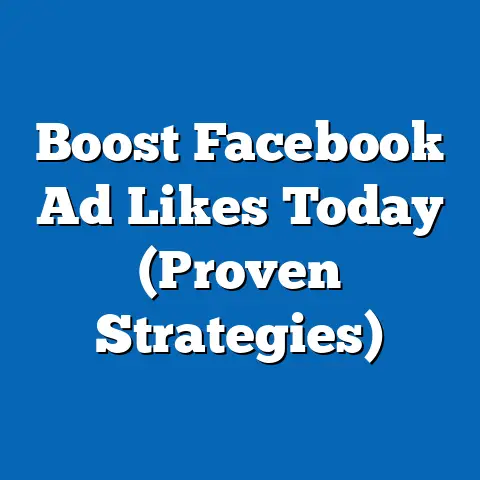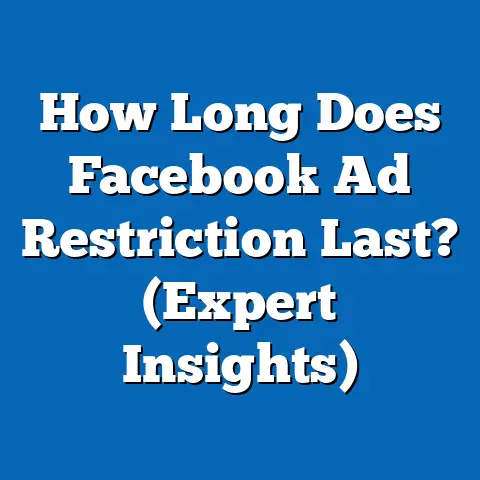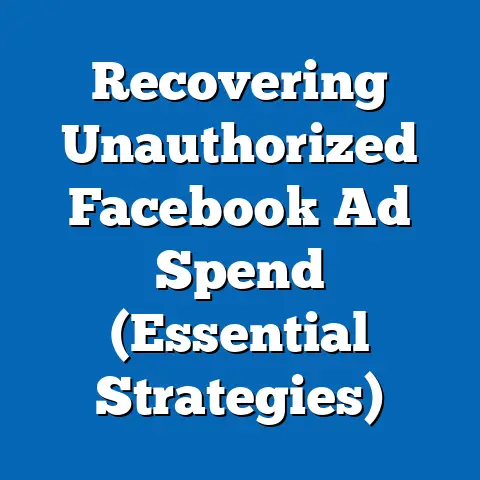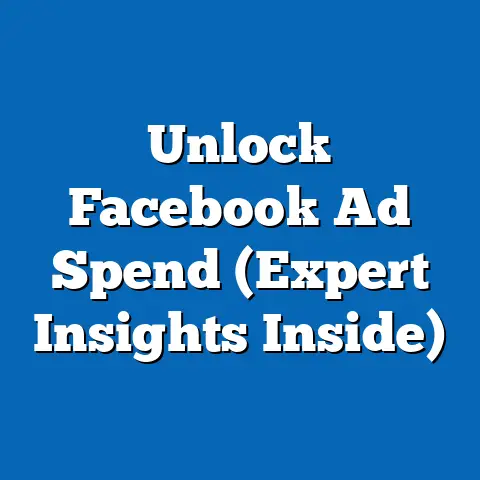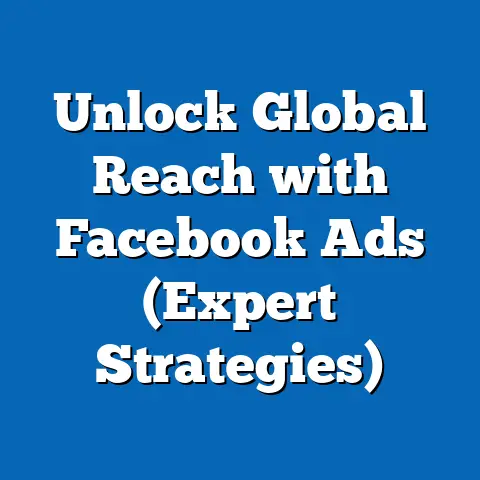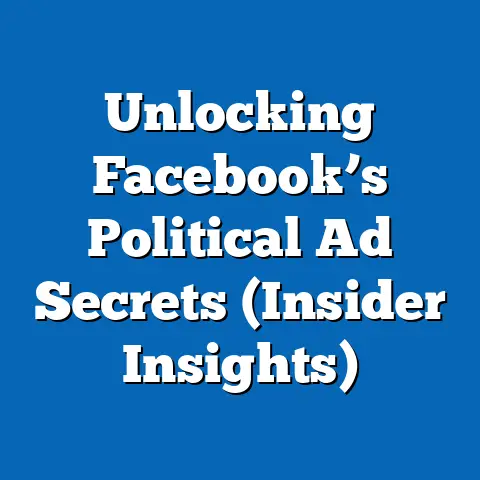Unlock Cost Options for Facebook Engagement Ads (Expert Insights)
I’ve been working with Facebook Ads for over a decade now, and I’ve seen firsthand how the platform has evolved. One thing that remains constant, however, is the need to understand and optimize your costs. In today’s digital age, where smart homes are no longer a futuristic dream but a rapidly growing reality, effective advertising is more crucial than ever. Technology is transforming our everyday lives, making homes smarter, more efficient, and more connected. This shift presents a massive opportunity for businesses in the smart home sector, but it also means increased competition for consumer attention.
Facebook, with its billions of users, remains a vital platform for reaching potential customers. However, simply throwing money at ads isn’t enough. You need a strategic approach, and that starts with understanding the cost options for Facebook engagement ads. These ads are designed to spark conversations, build brand awareness, and ultimately drive conversions. But how do you make sure you’re getting the most bang for your buck?
Understanding Facebook Engagement Ads
Facebook engagement ads are specifically designed to generate interactions with your content. Unlike ads focused solely on driving traffic to a website or generating leads, engagement ads prioritize building a community around your brand and fostering meaningful connections with your target audience. These ads encourage users to like, share, comment, and react to your posts, videos, or events.
The purpose of engagement ads within a broader digital marketing context is multifaceted. They’re not just about vanity metrics; they play a crucial role in:
- Boosting Brand Awareness: Increased engagement leads to wider visibility of your brand within the Facebook ecosystem. When users interact with your ads, their actions are often shared with their friends, expanding your reach organically.
- Building a Community: Engagement ads foster a sense of community around your brand. By encouraging conversations and interactions, you create a space where customers can connect with each other and with your business.
- Driving Conversions: While not the primary goal, engagement can indirectly lead to conversions. When users feel connected to your brand, they’re more likely to trust your products and services, ultimately leading to purchases.
Different Types of Engagement Metrics
Understanding the different types of engagement metrics is crucial for measuring the success of your ads. The most common metrics include:
- Likes: A simple indication of approval or interest in your content. While a high number of likes is generally positive, it’s important to consider the context. Are users liking your content because it’s genuinely engaging, or are they simply clicking the like button out of habit?
- Shares: Shares are a powerful form of engagement because they extend your reach beyond your immediate audience. When users share your content, they’re essentially endorsing your brand to their friends and followers.
- Comments: Comments provide valuable insights into what users think about your content. They allow you to engage in conversations, address concerns, and build relationships with your audience.
- Reactions: Facebook offers a range of reactions beyond the traditional “like” button, including “love,” “haha,” “wow,” “sad,” and “angry.” These reactions provide a more nuanced understanding of how users feel about your content.
- Saves: This metric indicates the number of people who have saved your content to view later. It’s a good indicator that your content is valuable and relevant to your audience.
Why are these metrics crucial for businesses, especially when promoting smart home products? In the smart home niche, trust and credibility are paramount. Consumers are often hesitant to invest in new technologies, especially if they’re unfamiliar with the brand. Engagement ads can help build trust by showcasing positive interactions with your products and services. For example, a video of satisfied customers raving about your smart thermostat can be far more persuasive than a traditional ad.
The Effectiveness of Engagement Ads
Recent trends show the effectiveness of engagement ads in driving conversions and brand awareness. According to a 2023 report by Statista, Facebook engagement rates are still high, with an average engagement rate of 0.08% per post. While this may seem small, it translates to significant reach when you consider the sheer volume of users on the platform.
Furthermore, a study by HubSpot found that businesses that actively engage with their audience on social media are more likely to see increased brand loyalty and customer lifetime value. This highlights the importance of not just running engagement ads, but also actively participating in the conversations they generate.
Key Takeaway: Facebook engagement ads are a powerful tool for building brand awareness, fostering community, and driving conversions. By understanding the different types of engagement metrics and actively participating in the conversations they generate, you can unlock the full potential of these ads for your smart home business. The next step is to understand how these ads are priced, which I’ll cover in the next section.
The Cost Structure of Facebook Engagement Ads
Understanding the cost structure of Facebook engagement ads is essential for maximizing your return on investment. Facebook offers a variety of pricing models, each with its own advantages and disadvantages. Let’s delve into the most common options:
Cost Per Click (CPC)
CPC is a pricing model where you pay each time someone clicks on your ad. This is a popular option for businesses that want to drive traffic to their website or landing page. With CPC, you only pay when someone takes a specific action, making it a relatively low-risk option.
- How it works: You set a maximum bid for each click, and Facebook’s algorithm determines whether your ad is shown based on your bid and the relevance of your ad to the user.
- Best for: Businesses that want to drive traffic to their website or landing page and have a clear call to action.
- Considerations: CPC can be more expensive than other pricing models if your ad is not highly relevant to your target audience. You need to ensure your ad copy and creative are compelling enough to entice users to click.
Cost Per Thousand Impressions (CPM)
CPM is a pricing model where you pay for every 1,000 times your ad is shown to users, regardless of whether they click on it or not. This is a good option for businesses that want to increase brand awareness and reach a large audience.
- How it works: You set a bid for every 1,000 impressions, and Facebook’s algorithm determines whether your ad is shown based on your bid and the relevance of your ad to the user.
- Best for: Businesses that want to increase brand awareness and reach a large audience, even if they don’t necessarily click on the ad.
- Considerations: CPM can be less effective if your ad is not highly engaging or relevant to your target audience. You need to ensure your ad is visually appealing and captures the attention of users as they scroll through their newsfeeds.
Cost Per Engagement (CPE)
CPE is a pricing model where you pay for each engagement your ad receives, such as a like, share, comment, or reaction. This is a good option for businesses that want to build a community around their brand and foster meaningful connections with their target audience.
- How it works: You set a bid for each engagement, and Facebook’s algorithm determines whether your ad is shown based on your bid and the relevance of your ad to the user.
- Best for: Businesses that want to build a community around their brand and foster meaningful connections with their target audience.
- Considerations: CPE can be more expensive than other pricing models if your ad is not highly engaging or relevant to your target audience. You need to ensure your ad copy and creative are designed to encourage interactions.
Average Costs and Influencing Factors
The average costs associated with running engagement ads on Facebook can vary widely depending on a number of factors, including:
- Target Audience: The more specific your target audience, the higher the cost. For example, targeting a niche demographic with specific interests will likely be more expensive than targeting a broad audience.
- Ad Placement: Ads placed in the Facebook newsfeed tend to be more expensive than ads placed in the right-hand column. This is because newsfeed ads are more visible and tend to generate higher engagement rates.
- Competition: The more businesses that are bidding on the same target audience, the higher the cost. This is particularly true during peak advertising seasons, such as holidays or product launches.
- Ad Quality: Facebook rewards high-quality ads with lower costs and wider reach. This means that ads with compelling copy, visually appealing creatives, and relevant targeting will generally perform better and cost less.
According to recent data from WebFX, the average CPC for Facebook ads across all industries is around \$0.97, while the average CPM is around \$7.19. However, these numbers can vary significantly depending on the factors mentioned above.
Key Takeaway: Understanding the different cost options for Facebook engagement ads is crucial for maximizing your return on investment. By carefully considering your goals, target audience, and ad quality, you can choose the pricing model that best suits your needs and optimize your campaigns for cost efficiency.
Expert Insights on Cost Optimization
Now that you have a solid understanding of the cost structure of Facebook engagement ads, let’s explore some expert insights on how to optimize your costs and get the most bang for your buck. I’ve learned these strategies over years of managing campaigns, and they’re proven to deliver results.
The Power of Audience Targeting
One of the most effective ways to lower your costs and increase your engagement rates is to refine your target demographics. Facebook’s targeting options are incredibly granular, allowing you to reach specific groups of people based on their interests, behaviors, demographics, and more.
For example, if you’re selling smart thermostats, you might target homeowners who are interested in energy efficiency, home automation, or green living. You could also target people who have recently purchased a new home or are planning to renovate their existing home.
By narrowing down your target audience, you can ensure that your ads are only shown to people who are genuinely interested in your products or services. This will not only increase your engagement rates but also lower your costs, as you’re not wasting money showing your ads to irrelevant users.
I’ve seen this firsthand with my clients. One client, a smart lighting company, was initially targeting a broad audience of homeowners. After refining their targeting to focus on homeowners interested in interior design and smart home technology, their engagement rates doubled, and their costs were cut in half.
A/B Testing for Ad Creatives and Messaging
A/B testing, also known as split testing, is a powerful technique for determining which ad creatives and messaging resonate most with your audience. By creating multiple versions of your ad and testing them against each other, you can identify the elements that drive the highest engagement rates and optimize your campaigns accordingly.
For example, you might test different headlines, images, or call-to-action buttons to see which ones perform best. You could also test different targeting options to see which audience segment is most responsive to your ads.
Facebook’s Ads Manager makes A/B testing relatively easy. You can create multiple versions of your ad within the same campaign and track their performance in real-time. By analyzing the data, you can quickly identify the winning variations and allocate more budget to them.
One of the biggest mistakes I see advertisers make is failing to A/B test their ads. They create a single ad and assume it will perform well. But without testing, you’re essentially guessing what your audience wants to see. A/B testing eliminates the guesswork and allows you to make data-driven decisions.
The Importance of Ad Relevance Score
Facebook’s Ad Relevance Score is a metric that measures the quality and relevance of your ads to your target audience. The higher your Relevance Score, the lower your costs and the wider your reach.
Facebook calculates the Relevance Score based on a variety of factors, including:
- Positive Feedback: Likes, shares, comments, and reactions.
- Negative Feedback: Reports of being offensive or misleading.
- Landing Page Experience: How quickly your landing page loads and how relevant it is to your ad.
To improve your Ad Relevance Score, focus on creating high-quality ads that are relevant to your target audience. Use compelling copy, visually appealing creatives, and clear call-to-action buttons. Also, make sure your landing page is optimized for speed and relevance.
I’ve found that ads with high Relevance Scores not only cost less but also generate more conversions. This is because Facebook rewards ads that provide a positive user experience.
Expert Quotes and Case Studies
“The key to successful Facebook advertising is to focus on providing value to your target audience,” says Neil Patel, a renowned digital marketing expert. “When you create ads that are genuinely helpful or entertaining, you’re more likely to generate engagement and build brand loyalty.”
Another expert, Amy Porterfield, recommends focusing on building relationships with your audience through engagement ads. “Don’t just try to sell them something,” she advises. “Instead, focus on creating conversations and building a community around your brand.”
One of my clients, a smart home security company, implemented these strategies and saw a significant improvement in their Facebook advertising results. They started creating ads that showcased the benefits of their products and provided helpful tips for home security. They also actively engaged with their audience in the comments section, answering questions and addressing concerns. As a result, their engagement rates soared, their costs plummeted, and their conversion rates skyrocketed.
Key Takeaway: Cost optimization is an ongoing process that requires continuous testing and refinement. By refining your target demographics, A/B testing your ads, and focusing on ad relevance, you can significantly lower your costs and increase your engagement rates.
Practical Tips for Budgeting Facebook Engagement Ads
Budgeting for Facebook engagement ads can be tricky, especially for businesses in the smart home sector where competition is fierce. Here are some practical tips to help you allocate your resources effectively and maximize your return on investment.
Setting Clear Objectives and KPIs
Before you even think about setting a budget, it’s crucial to define your objectives and key performance indicators (KPIs). What do you want to achieve with your Facebook engagement ads? Are you trying to increase brand awareness, build a community, or drive conversions?
Once you’ve defined your objectives, you can set specific KPIs to measure your progress. For example, if you’re trying to increase brand awareness, you might track metrics such as reach, impressions, and website traffic. If you’re trying to build a community, you might track metrics such as likes, shares, comments, and reactions.
Setting clear objectives and KPIs will help you stay focused and avoid wasting money on ads that don’t contribute to your goals.
Allocating Budgets Across Ad Sets and Campaigns
Facebook allows you to allocate budgets at both the ad set and campaign levels. Ad sets are groups of ads that share the same targeting options, placements, and budget. Campaigns are groups of ad sets that share the same objective.
When allocating budgets, consider factors such as:
- Target Audience Size: The larger your target audience, the more budget you’ll need to reach them effectively.
- Competition: The more businesses that are bidding on the same target audience, the more budget you’ll need to compete.
- Ad Relevance: The higher your Ad Relevance Score, the less budget you’ll need to achieve your goals.
I typically recommend starting with a smaller budget and gradually increasing it as you see positive results. This allows you to test different targeting options and ad creatives without risking a large amount of money.
Seasonal Trends, Product Launches, and Promotional Events
Your budgeting strategy should also take into account seasonal trends, product launches, and promotional events. For example, if you’re launching a new smart home product, you might want to increase your budget in the weeks leading up to the launch to generate buzz and excitement.
Similarly, if you’re running a promotional event, such as a Black Friday sale, you might want to increase your budget during the event to drive sales.
By aligning your budgeting strategy with key events and trends, you can maximize your return on investment and achieve your goals more effectively.
Monitoring Performance Metrics in Real-Time
Finally, it’s crucial to monitor your performance metrics in real-time and adjust your spending accordingly. Facebook’s Ads Manager provides a wealth of data that can help you track your progress and identify areas for improvement.
Pay close attention to metrics such as:
- Reach: The number of unique people who saw your ad.
- Impressions: The number of times your ad was shown.
- Engagement Rate: The percentage of people who interacted with your ad.
- Cost Per Engagement: The average cost you paid for each engagement.
- Conversion Rate: The percentage of people who took a desired action after seeing your ad (e.g., making a purchase, signing up for a newsletter).
By monitoring these metrics, you can identify underperforming ads and ad sets and make adjustments to improve their performance. You can also identify opportunities to scale your successful ads and ad sets.
Key Takeaway: Budgeting for Facebook engagement ads is an ongoing process that requires careful planning, monitoring, and adjustment. By setting clear objectives and KPIs, allocating budgets strategically, and monitoring performance metrics in real-time, you can maximize your return on investment and achieve your goals more effectively.
As the smart home market continues to evolve, effective advertising will become even more crucial for businesses looking to stand out from the competition. By leveraging the insights provided in this article, you can enhance your Facebook advertising efforts and drive engagement with your target audience.
Remember, Facebook advertising is not a one-size-fits-all solution. It requires continuous testing, refinement, and adaptation. By staying informed, experimenting with new strategies, and monitoring your results, you can unlock the full potential of Facebook engagement ads and achieve your business goals. So, go ahead, dive into the world of Facebook advertising, and start building a community around your smart home brand today!

